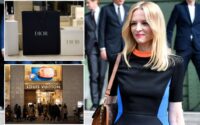‘Bragging that you’re not influenced’
An influencer’s raison d’etre is influencing their followers to buy stuff — usually on behalf of a paying sponsor.
That’s why it’s so surprising that “underconsumption-core,” an increasingly popular trend in which people boast their under-spending, has emerged as a rebuttal to influencer culture.
“TikTok has turned almost everything into an opportunity for consumerism,” beauty writer and newsletter author Laura Capon told Business of Fashion, adding that “even going for a walk is a shopping experience.”
But on that same platform, the tag #underconsumption has proliferated, boasting over 5,000 posts in which minimalists proudly show off their simplified skincare routines, thrifted furniture, vintage clothing, the four pairs of shoes they’ve had in rotation for years and the one purse they use every single day.
“It just gets so tiring watching people tell me that this is the newest thing that I have to buy,” Adeline Um, 27, told Fortune, lamenting the “oversaturation” of consumerism on her social feeds.
“There are some real makeup addicts … it’s a crazy amount of overspending,” Capon said.
To say you’re underconsuming, then, is like “bragging that you’re not influenced,” she added.
“Just a reminder that you dont need to be buying a million products to feel pretty and to take care of yourself,” NYC-based Kristen B., 24, wrote in the caption of her recent “underconsumption core” TikTok video.
The creator, who gives financial advice online, boasted a skincare routine of just cleanser, moisturizer and retinol, along with less than five products used in the shower, a “minimally decorated kitchen” and only a handful of makeup and haircare tools and products.
“I’ve started living a life of underconsumption and have felt so much more peace. Trying to keep up with the trends is EXHAUSTING,” commented one viewer.
“That’s not underconsumption , that’s normal consumption,” argued another.
Similarly, many users argued that an average amount of product consumption is only jarring and seems like under-spending when compared to the extravagant over-spending of people online.
“Underconsumption TikTok … is literally just my everyday life,” another creator, who only goes by Kristen, explained in a recent clip, in which she reminded viewers that it is “normal” to keep the same clothes in rotation and not constantly shop new.
In the kitchen of another creator, they only use two cutting boards that they’ve “had forever,” spices that are kept in their original packaging, decor that has been gifted or under $10, hand-me-down utensils, free or old cookbooks and a kitchen table that has had “at least three previous owners.”
The run-of-the-mill refrigerator, the TikTokker described, was not as aesthetically pleasing as others often seen on the app, where influencers place products, spices and other food items into clear, plastic containers.
“You don’t want to waste the thing that you’ve already invested in or purchased; you want to optimize that,” Holly O’Neill, Bank of America’s president of retail banking, told Fortune.
“That both has a budget and a sustainability impact. I mean, we all know the satisfaction of using everything that you purchase and not wasting it. Gen Z is very attuned to that.”
Some users, however, have taken the trend one step too far by keeping broken plates, tattered items, overly-worn shoes and expired makeup, the latter of which could be a health concern.
While wanting or needing “to purchase items isn’t bad,” Um said, there’s no need to purchase something new if the thing you already have works perfectly fine — the trend cycle be damned.
“You don’t need to buy a new set of hair straighteners just because your current ones are crusty,” she said. “If it still works, it still works. For me, it’s actually been a great reminder.”
The online movement — which follows in the footsteps of de-influencing, no-spend years and the Gen Z obsession with shopping second-hand — is, in part, a product of inflation.
Zoomers in particular have been especially vocal about their struggles to afford basic necessities as things grow more expensive. New York City, for one, was among the cities hit the hardest by inflation, according to recent reports.
“They’re feeling the high cost of living,” O’Neill said. “They know they need to set a budget, and they know they need to find ways to cut back, and they look at those budgets…in order to meet those priorities.”


